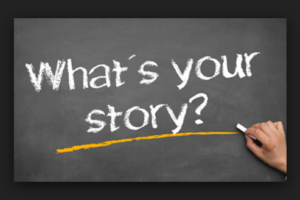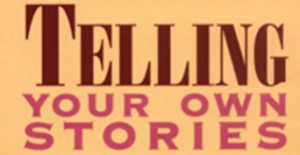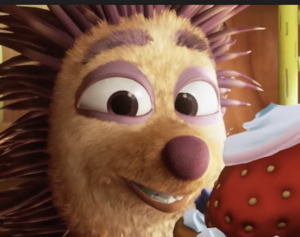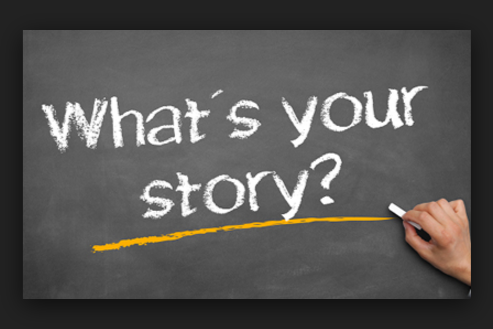Like to read great online stories? How about telling stories? Extraordinary stories and storytelling are a great way to spread ideas. That is an important reason the online stories and storytelling guidebook is an essential asset.

You have to understand, my dears, which the shortest distance between truth and a human being is a story.
—Anthony de Mello, from One Minute Wisdom
If you want to be remembered then touching hearts is where it happens. Many content marketers are discovering that storytelling has a power that they have ignored but are struggling to stand out in a sea of brand blandness.
Related post: 11 Steps to Media Framing Messages for Optimum Engagement
Certainly, you have noticed the tremendous abundance of marketing strategy choices in the marketplace today. No needs go wanting, do they? Consumers have everything they need, and therefore their decisions are based on what they want. And what they want is driven by what they believe.
Great storytelling and stories are a very integral part of being persuasive. If you want to persuade your customers and create a memorable experience at the same time, you must master the psychology of storytelling.

Online stories … understanding stories and storytelling
Here are some story/storytelling characteristics that are useful in understanding this marketing technique:
Are authentic, and people should never question
They make a promise that has some meaning to the community
Are targeted to a particular community
They make subtle points … and are not overwhelming
They are a trusted marketing tool
Stories and storytelling appeal to our senses and not to logic
And most importantly they are told with heart to appeal to emotions

Why stories and storytelling?
Facts often can be boring and overwhelming, can’t they? Stories, though, not nearly as much. They are much easier to understand and much more entertaining. Therefore they are much better at spreading ideas.
Facts are meaningless without a contextual story. Don’t tell facts to influence, tell stories. The more you improve storytelling, the more your influence increases… it is as simple as that.
Stories make it easier for people to understand. They are the best way, by far, to spread your ideas. Especially when there is a large competition for people’s attention.
Story element examples

Here are some perfect examples of the elements of stories:
The point
The Wizard of Oz
Every story should have a point. How often have we been regaled with high drama and intricate detail, only to have no payoff? Most of us have seen The Wizard of Oz and can sing out in unison Dorothy’s final words in the story, “There’s no place like home.” Without that, and without her realization of what she values, her adventures are all for naught. Make sure you have a payoff in your stories.
A dramatic question
Raiders of the Lost Ark
“Will Indiana find the Ark before the Nazis get it?” is the lynchpin, the conflict of the entire story. Once that question is answered, the story ends. But wait: there’s more. A great answer to a dramatic question can have an ironic twist. The answer usually is not merely, “Yes.” Instead, it’s, “Well, yes…but…” In Raiders the answer is “Yes, but the Ark contains inconceivable power…more than we care to handle.”
The final shot reveals The Ark stored inconspicuously in a massive warehouse. The irony is complete. You should develop stories with both dramatic questions and ironic twists if possible.
Content that includes emotion
Apollo 13
The first time I saw Apollo 13 I was on the edge of my seat asking the question: “Will they make it back?” On the edge of my seat, I watched as the characters struggled, toiled, prayed to get the astronauts home.
Then I took a step back…:”Wait. I was there when this happened. They make it back!” So what compels me to watch the remainder of this film every time it comes on? Ron Howard has the uncanny ability to make the audience care about what happens to the characters. Whether it be through the riveting soundtrack, poignant conversations between husband and wife, or struggles between colleagues, we care.
Create stories that cause us to feel, to empathize, to understand, is critical. Emotion should be created in every facet of the story: words, images, voice, and music. That should be your objective.
Set a pace
Lord of the Rings
Notice any emotional scene between Frodo and Sam, or characters that have romantic connections in the Lord of the Rings? In this story shots are long in duration, the movement is subtle, and the soundtrack is smooth and peaceful.
Contrast that with the epic battle scenes: shots are quick with no transitions, quick zooms and sweeping panoramas of the battlefield dominate the scene and the music: as powerful and relentless as the battle itself. All of the elements come together to develop a consistent pace or rhythm of the scene, don’t they?
At times, however, an intentional contrast can achieve a great effect. Why would a director deliberately use slow motion and cut out the soundtrack at a particular point in a battle scene? To draw attention, of course.
Gift of voice
Stand By Me
Often, people become reluctant about recording their voice for others to hear. Voice-over personalizes a story to an intimate level. The narration of Richard Dreyfus as the adult Gordy LeChance, in the movie Stand By Me, adds a nostalgic tone of reminiscence to a bygone era. Clearly, voice impacts emotional content as well.
Less is more economy
Master Card “Badger” commercials
This is where the mantra, “Less is More” comes out. No one needs to be a more economical storyteller than commercial writers. The entire process must be completed in no more than 30 seconds in most cases. The old Master Card commercials about the hard-luck dog badger attempting to get home are masterpieces of the economy. Make your objective to use fewer images and words to convey meaning. This technique can pay big dividends.
Powerful soundtrack
Jaws
Need I say more about the impact of the trademark “Da-dum. da-dum-da-dum.” Don’t leave the soundtrack to an afterthought. Its choice can make a huge impact. Choose the soundtrack as instrumental music in lieu of lyrical.
Online stories for adults … storytelling how to’s
How do you make your ideas more compelling? Even if your message is true and important, it’s hard to reach a general audience with facts alone. Tell awesome stories that are memorable – stories have the power to captivate and inspire people, from high school students, busy parents, or even members of Congress.
Awesome stories surprise us. They have compelling characters. They make us think, make us feel. They stick in our minds and help us remember ideas and concepts in a way that numbers and text on a slide with a bar graph don’t.
Stories make presentations better. Stories make ideas sticky. They help us persuade. Savvy leaders tell stories to inspire us, motivate us. (That’s why so many politicians tell stories in their speeches.) They realize that “what you say” is often moot compared to “how you say it.”
Here are 14 steps we recommend to create and tell an awesome story:
Step 1 Engage your audience
Your audience needs something to do. They need a reason to be there, listening. Stories, when properly practiced, pull people into a dialogue. It’s about engagement and interaction. The audience is just as an active a participant as the storyteller.
Ask the audience to think back to early passions and interests and bundle the story with specific experiences. Show them this is important, this is remarkable, and you are a part of it.
Step 2 Make the audience care
Whenever I am fortunate enough to see and listen to remarkable stories being told ‘live’ in action, I am struck by their power to pull listeners in, much like a gravitational force that’s impossible to resist.
The best way to pull your audience in is to make them care … emotionally, intellectually, aesthetically. But how do you make the audience care? This is the most fundamental question of all. There is no single answer. One important answer is having empathy for your audience and trying to craft your story and design your content always with the audience in mind.
Stories in all their many forms are never just about transferring information alone. We are emotional beings, like it or not, and to make the audience care enough to listen to you, you have to evoke in them some emotion. See our article on the Guinness storytelling strategy in this regard.
Step 3 Explain why the story matters
Make it clear to your audience why what we were seeing and hearing matters. Even if it is not always explicitly stated, the message should be clear.
It is hard to choose just one element that a successful story must have, but if I had to choose just one, I’d say it is this: Show clearly why your topic — or result, cause, mission, etc. — matters. What are the big picture and our place in that picture?
Pixar’s Andrew Stanton said something very similar when he identified the most important element of storytelling as ‘make me care.’ You must make the audience care. And you must let them know clearly why it matters.
Step 4 Make a promise
Very early on you need to get the audience to believe that this story is going to go somewhere and that it will be worth their time. The secret is a well-told promise about the upcoming story.
Step 5 Construct anticipation
In a great story, the audience wants to know what happens next and most of all how it all concludes. In an explanatory narrative, a series of actions can establish a narrative flow and the sense of journey that is created is one form of anticipation of what comes next.
A good story has a beginning where a sympathetic character encounters a complicating situation, a middle where the character confronts and attempts to resolve the situation and an end where the outcome is revealed. It does not interpret or explain the action in the story for the audience.
Instead, a good story allows each member of the audience to interpret the story as he or she understands the action. This is why people find good stories so appealing and why they find advertising that simply conveys facts and information boring.
Step 6 Spark their curiosity
Your goal is to tell stories in an opening, an aperture of excitement. Ignite the fires of curiosity that will live within us all. It’s a celebration of human curiosity, and it matters to who and what we are. You don’t have to beat people over the head with your message, nor do you need always to make your message painfully obvious.
This is not about being vague or unclear, but it is about letting the audience work on their own a little to figure things out by creating some curiosity. That’s one of your jobs as a storyteller. We’re born problem solvers. We’re compelled to deduce and to deduct because that’s what we do in real life. It’s this well-organized absence of information that draws us in.
Step 7 Touch audiences with emotional connection
The Google Reunion story, discussed in the next chapter, is about as emotional as it gets. Stories like this provide a chance to experience a variety of emotions without the risk of those emotions themselves. Emotions like wonder, fear, courage, or love can be tested out in the minds of those as they listen to a story. You may remember the feelings of emotions which can trigger memories or create resolve as a result of hearing such stories. The experience of hearing stories can awaken portions of emotional lives that may have lain dormant or have not yet been explored.
Be dynamic with your stories like Google was in this story. Nothing is more important to narrative content than imagination, so give vivid descriptions and use emotional hooks and humor to get people fully engaged. This story engages us, doesn’t it? Be creative, not only with words and images but also with the methods you use to convey them. Like the music as well as the messages.
Step 8 Talk about memorable human interest
Storytelling is largely an act of curation. The greats detect stories as they move through life and then pull them together in ways that make us stop and think.
Step 9 Make it personal
Well-told stories can help us to learn about other cultures, ideas, and ways of thinking. They can provide opportunities to know how past generations responded to challenges. They can also let us know how new generations are encountering and dealing with similar opportunities or the new challenges they face.
Use a creative story that builds on some big forces such as politics, religion, geography, nationalism. If you listen to your customers, you can leverage their stories to drive your creativity.
Step 10 Trigger a question
Good storytelling causes the audience to ask questions as your narrative progress. As the storyteller, you can ask questions directly, but often a more interesting approach is to present the material in a way that triggers the audience to come up with the questions themselves. And yet we must not be afraid to leave some questions unanswered.
When we think of a story, we may think of clear conclusions and neat, clear endings, but reality can be quite a bit more complicated than that. There are an infinite amount of mysteries to ponder and puzzles to be solved. Many observations cannot (yet) be explained, but that is OK. This is what keeps us going forward.
Step 11 Emphasize the visual
“Show the readers everything, tell them nothing.” – Ernest Hemingway
Here visual does not mean only the use of graphics such as photography, video, animations, visualizations of data, and so on.
Visual also means helping the audience to clearly “see” your ideas through your use of descriptive language, through the use of concrete examples, and by the power and simplicity of metaphor.
Step 12 Make the tough choices about inclusion and exclusion
Whether you have 5-minutes, 18-minutes, or an all-day seminar in which to tell your story, it is never enough time to tell all that you know or to share everything in as much detail as possible. Time can be a real obstacle, but it’s also a great enabler if you are willing and able to put in the time to think long and hard about what’s the most important and what’s less important for reaching your audience in a way that is honest, informative, and engaging.
You can’t include all that you know or all that there is to say. The secret is in knowing what to leave out. This is not easy. Balance is key.
Step 13 Story is about change
We’re all learning all the time. And that’s why change is fundamental in a story. Remember, life is never static.
Think of change in two ways. First, the content of every good presentation or story addresses a change or some kind.
Second, an effective presentation or a story told well will create a change in the audience. Don’t let the only change you create be in your audience be the change from wakefulness to sleep.
Step 14 Show a sense for the future
A good story is a mix of logic, data, emotion, and inspiration. We usually do fine with the logic and data part, but fail on the emotional and inspirational end. Certainly, we need to infuse a bit of the future into our talks to inspire people to make a change. Most importantly, a good story should not end when the speaker sits down, or the class comes to an end.
Storytelling tips and tricks … secrets of success
To be most successful, stories and storytelling must play to these secrets:
They must reinforce existing popular views.
Call attention to something new.
Focus on first impressions.
Tell only what YOU believe.
Be authentic.
Telling
Learn to appreciate and then tell … both sides of the story.
Experiment
Experiment with styles and don’t be afraid of trying new things. Watch your audience to see what works best.
Routine
Get into a routine … and stick to it. Build strong habits.
Read a lot
Reading is your best source of great ideas … diverse sources/topics, read a lot all the time.
Take notes
Take notes on all ideas, good and bad, then combine them in novel ways. Save all the best ideas/favorite things you find … and revisit often.
Key takeaways
Great storytelling and stories are a very integral part of being persuasive. If you want to persuade your customers and create a memorable experience at the same time, you must master the psychology of storytelling. Give them a try today.
Mike Schoultz is the founder of Digital Spark Marketing, a digital marketing and customer service agency. With 40 years of business experience, he blogs on topics that relate to improving the performance of your business. Find them on G+, Twitter, and LinkedIn.
More reading on marketing strategy from Digital Spark Marketing’s Library:
Marketing Branding … 9 Secrets to a Continuous Improvement Strategy
